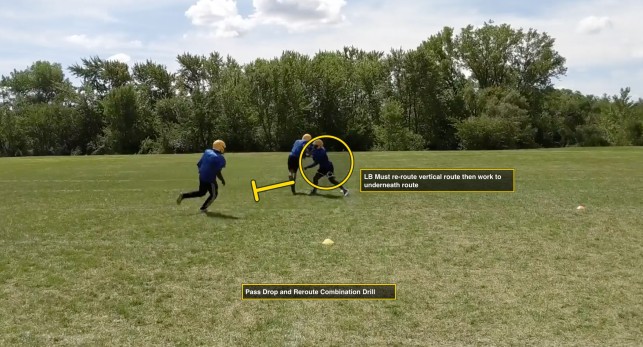By Keith J. McMaster
Defensive Coordinator
Crete-Monee High School (IL)
Twitter: @keithmcmaster
Today’s version of football has become very restrictive when it comes to what a defense can or cannot do. The rules have trended towards more scoring and higher offensive output making the life of a defensive coordinator more and more complex. The physicality and violent plays are becoming obsolete. Therefore, the defense must use every available method to disrupt, intimidate and attack the opposing team. One of the physical aspects that our team constantly teaches is the physical re-route of receivers, especially from the linebacker position.
This oft-forgotten technique has huge benefits for our defense. A direct result of our physical play has been the decrease of passing yards per game and completion percentage while the sacks, interceptions, and pick-sixes have risen. This puts extreme pressure on an opposing offense when the receivers constantly need to alter routes and make the quarterback work harder and take longer for a single completion. Whether in press man or zone coverage, the main focus of our linebackers is physical re-routes to take away the middle of the field.

Re-Route: Footwork
Before a linebacker can even think about re-routing a receiver, coaches must ensure his footwork is correct. Most teams work linebacker drops; however, this drill focuses on what happens when the linebacker meets the receiver in his zone after his drop. The linebacker's footwork must be in the proper position to strike and disrupt a defender.
To start the drill, begin with a linebacker and a receiver in close vicinity, if the linebacker has already read his keys, read the pass, and has dropped into his coverage. For setup, start with a receiver that is in a position to work through the linebacker zone. The linebacker begins on a 45-degree angle as if he’s working a hook to curl drop. However, to guarantee the defender is using his feet correctly, have him place both hands behind his back in an athletic position. This forces him to work on body positioning to control the direction of the receiver.
You can work two different routes with the receiver: a vertical route and an underneath route. On go, the receiver will attempt one of the two routes. For the vertical route, the linebacker works on maneuvering his outside hip to the receiver’s inside hip. The inside foot then walls off the inside, forcing the receiver outside. For an underneath route, the inside hip matches the outside hip of the receiver. It is followed by the linebackers outside foot stepping forward. Many times, this technique alone will cause contact and disruption with the receiver. Once the footwork has been accomplished, the strike and punch will follow.
Defensive Coordinator
Crete-Monee High School (IL)
Twitter: @keithmcmaster
Today’s version of football has become very restrictive when it comes to what a defense can or cannot do. The rules have trended towards more scoring and higher offensive output making the life of a defensive coordinator more and more complex. The physicality and violent plays are becoming obsolete. Therefore, the defense must use every available method to disrupt, intimidate and attack the opposing team. One of the physical aspects that our team constantly teaches is the physical re-route of receivers, especially from the linebacker position.
This oft-forgotten technique has huge benefits for our defense. A direct result of our physical play has been the decrease of passing yards per game and completion percentage while the sacks, interceptions, and pick-sixes have risen. This puts extreme pressure on an opposing offense when the receivers constantly need to alter routes and make the quarterback work harder and take longer for a single completion. Whether in press man or zone coverage, the main focus of our linebackers is physical re-routes to take away the middle of the field.

Re-Route: Footwork
Before a linebacker can even think about re-routing a receiver, coaches must ensure his footwork is correct. Most teams work linebacker drops; however, this drill focuses on what happens when the linebacker meets the receiver in his zone after his drop. The linebacker's footwork must be in the proper position to strike and disrupt a defender.
To start the drill, begin with a linebacker and a receiver in close vicinity, if the linebacker has already read his keys, read the pass, and has dropped into his coverage. For setup, start with a receiver that is in a position to work through the linebacker zone. The linebacker begins on a 45-degree angle as if he’s working a hook to curl drop. However, to guarantee the defender is using his feet correctly, have him place both hands behind his back in an athletic position. This forces him to work on body positioning to control the direction of the receiver.
You can work two different routes with the receiver: a vertical route and an underneath route. On go, the receiver will attempt one of the two routes. For the vertical route, the linebacker works on maneuvering his outside hip to the receiver’s inside hip. The inside foot then walls off the inside, forcing the receiver outside. For an underneath route, the inside hip matches the outside hip of the receiver. It is followed by the linebackers outside foot stepping forward. Many times, this technique alone will cause contact and disruption with the receiver. Once the footwork has been accomplished, the strike and punch will follow.









